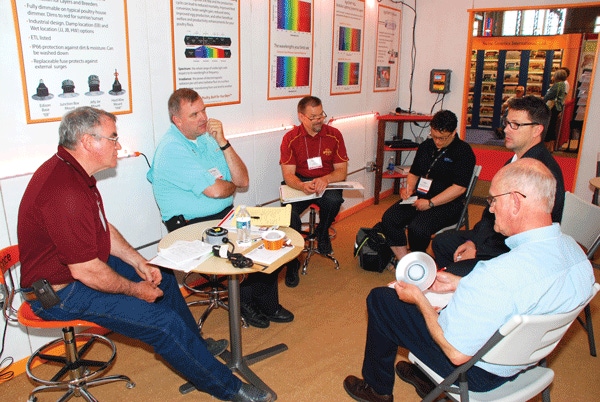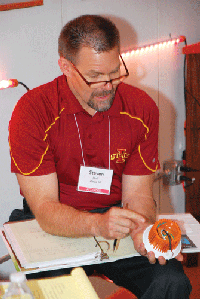2013 World Pork Expo New Product Tour: Once Innovations LED Swine Light
This LED light replaces incandescent bulbs in hog barns

Lighting can make a big difference in the lives of pigs and for the people who are working with them. Brian Wilcox, president of Once Innovations, provided the new product review panel members with an extensive list of benefits for the company’s new 14-watt, LED lighting product, developed specifically for the swine market.
The new light replaces incandescent bulbs, and can be used in existing barns or in new construction. Retrofit options can be installed in a standard “jelly jar” fixture socket.

Steve Hoff asked about retrofit options for the new product.
“Our goal was to create production-enhancing lights, not just energy savings,” Wilcox explained. “The three key aspects of animal-specific lighting are spectrum, irradiance and modulation. Providing the right spectrum of light, at the optimum irradiance, and modulating it properly throughout the day and at specific times in the production cycle can lead to reduced mortality, improved feed conversion, faster weight gain, reduced stress and other benefits.” Wilcox added that the ability to dim the lights can help mimic sunrise and sunset, and gives producers the ability to imitate photoperiods.
Research conducted in the broiler industry has shown that mimicking sunrise and sunset can actually help calm birds and also helps increase the size of the birds, resulting in additional pounds of (meat) protein at marketing time. Research is currently under way in the swine industry. Wilcox said pigs are particularly sensitive to green and blue light.
The 14-watt LED lighting product replaces a 100-watt incandescent lamp, and costs $39.90 for the 100-watt equivalent light. Rebates for the cost of the light are available from some utility companies because of the energy savings that can be realized.
A heavy-duty Ingress Protection (IP) rating of 66 helps the light withstand power washing, Wilcox said. The light comes with a three-year, 24/7 warranty.
Steve Hoff asked about the expected life span of the lights. Wilcox said testing has shown that producers could expect about 50,000 hours before having to change the lights.
The panel felt the solid design, power savings and ability to withstand power washing were definite advantages for producers. “It is intriguing to think about how the different colors of light may have the potential to change behavior during different phases of production,” Mike Ellis said.
Learn more at www.onceinnovations.com.
About the Author(s)
You May Also Like



